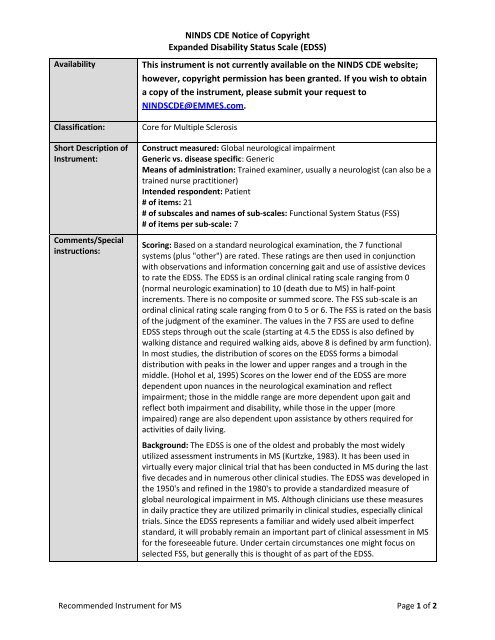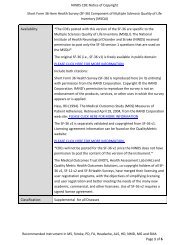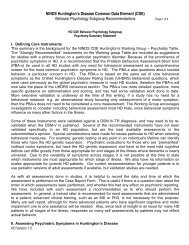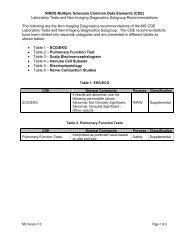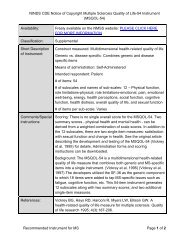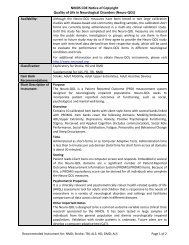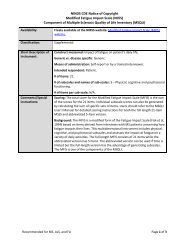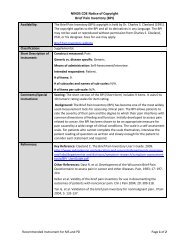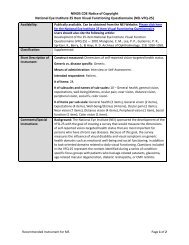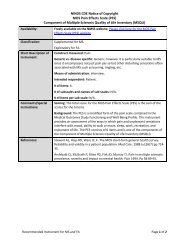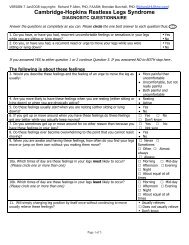Kurtzke Expanded Disability Status Scale (EDSS) - NINDS Common ...
Kurtzke Expanded Disability Status Scale (EDSS) - NINDS Common ...
Kurtzke Expanded Disability Status Scale (EDSS) - NINDS Common ...
You also want an ePaper? Increase the reach of your titles
YUMPU automatically turns print PDFs into web optimized ePapers that Google loves.
<strong>NINDS</strong> CDE Notice of Copyright<br />
<strong>Expanded</strong> <strong>Disability</strong> <strong>Status</strong> <strong>Scale</strong> (<strong>EDSS</strong>)<br />
Availability<br />
Classification:<br />
Short Description of<br />
Instrument:<br />
Comments/Special<br />
instructions:<br />
This instrument is not currently available on the <strong>NINDS</strong> CDE website;<br />
however, copyright permission has been granted. If you wish to obtain<br />
a copy of the instrument, please submit your request to<br />
<strong>NINDS</strong>CDE@EMMES.com.<br />
Core for Multiple Sclerosis<br />
Construct measured: Global neurological impairment<br />
Generic vs. disease specific: Generic<br />
Means of administration: Trained examiner, usually a neurologist (can also be a<br />
trained nurse practitioner)<br />
Intended respondent: Patient<br />
# of items: 21<br />
# of subscales and names of sub-scales: Functional System <strong>Status</strong> (FSS)<br />
# of items per sub-scale: 7<br />
Scoring: Based on a standard neurological examination, the 7 functional<br />
systems (plus "other") are rated. These ratings are then used in conjunction<br />
with observations and information concerning gait and use of assistive devices<br />
to rate the <strong>EDSS</strong>. The <strong>EDSS</strong> is an ordinal clinical rating scale ranging from 0<br />
(normal neurologic examination) to 10 (death due to MS) in half-point<br />
increments. There is no composite or summed score. The FSS sub-scale is an<br />
ordinal clinical rating scale ranging from 0 to 5 or 6. The FSS is rated on the basis<br />
of the judgment of the examiner. The values in the 7 FSS are used to define<br />
<strong>EDSS</strong> steps through out the scale (starting at 4.5 the <strong>EDSS</strong> is also defined by<br />
walking distance and required walking aids, above 8 is defined by arm function).<br />
In most studies, the distribution of scores on the <strong>EDSS</strong> forms a bimodal<br />
distribution with peaks in the lower and upper ranges and a trough in the<br />
middle. (Hohol et al, 1995) Scores on the lower end of the <strong>EDSS</strong> are more<br />
dependent upon nuances in the neurological examination and reflect<br />
impairment; those in the middle range are more dependent upon gait and<br />
reflect both impairment and disability, while those in the upper (more<br />
impaired) range are also dependent upon assistance by others required for<br />
activities of daily living.<br />
Background: The <strong>EDSS</strong> is one of the oldest and probably the most widely<br />
utilized assessment instruments in MS (<strong>Kurtzke</strong>, 1983). It has been used in<br />
virtually every major clinical trial that has been conducted in MS during the last<br />
five decades and in numerous other clinical studies. The <strong>EDSS</strong> was developed in<br />
the 1950's and refined in the 1980's to provide a standardized measure of<br />
global neurological impairment in MS. Although clinicians use these measures<br />
in daily practice they are utilized primarily in clinical studies, especially clinical<br />
trials. Since the <strong>EDSS</strong> represents a familiar and widely used albeit imperfect<br />
standard, it will probably remain an important part of clinical assessment in MS<br />
for the foreseeable future. Under certain circumstances one might focus on<br />
selected FSS, but generally this is thought of as part of the <strong>EDSS</strong>.<br />
Recommended Instrument for MS Page 1 of 2
<strong>NINDS</strong> CDE Notice of Copyright<br />
<strong>Expanded</strong> <strong>Disability</strong> <strong>Status</strong> <strong>Scale</strong> (<strong>EDSS</strong>)<br />
References:<br />
Rationale/<br />
Justification:<br />
Goodkin et al. Inter- and intrarater scoring agreement using grades 1.0 to 3.5 of<br />
the <strong>Kurtzke</strong> <strong>Expanded</strong> <strong>Disability</strong> <strong>Status</strong> <strong>Scale</strong> (<strong>EDSS</strong>). Multiple Sclerosis<br />
Collaborative Research Group. Neurology 1992 Apr;42(4):859-63.<br />
<strong>Kurtzke</strong> JF. Rating neurologic impairment in multiple sclerosis: an expanded<br />
disability status scale (<strong>EDSS</strong>). Neurology. 1983 Nov;33(11):1444-52.<br />
Strengths/Weaknesses: The <strong>EDSS</strong> has frequently been used as a primary or<br />
secondary outcome in clinical trials. Since the <strong>EDSS</strong> is an ordinal rating scale, a<br />
1-point difference in one part of the scale does not represent the same interval<br />
as a 1-point difference in another part of the scale, thus making change or<br />
group differences difficult to interpret. Most importantly, there is evidence that<br />
the <strong>EDSS</strong> lacks adequate sensitivity to fluctuations in MS-related impairment.<br />
The FSS is one of the oldest and probably the most widely utilized assessment<br />
instruments in MS (<strong>Kurtzke</strong>, 1983).<br />
Psychometric Properties: Both test-retest reliability and inter-rater agreement<br />
have varied considerably from study to study with some studies finding high<br />
values and other studies unacceptably low figures (Coulthard-Morris, 2000).<br />
However, dissatisfaction with the psychometric characteristics of the FSS have<br />
led investigators to develop other measures for clinical studies in MS, for<br />
example, the MSFC. Many investigators have attempted to correct some of the<br />
problems by making changes in the FSS. See for example Goodkin et al (1992).<br />
Availability: There have been several different versions of the <strong>EDSS</strong>, many of<br />
which have been used in clinical trials but not published. The version presented<br />
here is the one originally published by <strong>Kurtzke</strong> (1983) with some explanatory<br />
material added when the <strong>EDSS</strong> was incorporated in the Minimal Record of<br />
<strong>Disability</strong> by the World Health Organization.<br />
Administration: Will vary depending upon the condition of the patient and the<br />
skill of the examiner. Although the <strong>EDSS</strong> itself can be rated in a few minutes, the<br />
neurological examination and assessment of walking distance that is needed to<br />
make the ratings can take anywhere from 15-45 minutes.<br />
A version that can be administered by phone is also available (Lechner-Scott J et<br />
al, MSJ 2003; 9: 154-159)<br />
Recommended Instrument for MS Page 2 of 2


